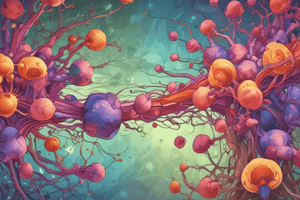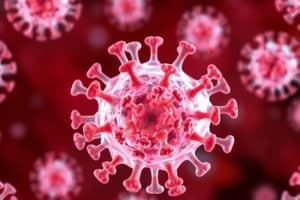Podcast
Questions and Answers
What is one of the primary roles of interleukin-1 (IL-1) in inflammation?
What is one of the primary roles of interleukin-1 (IL-1) in inflammation?
- It reduces blood flow to injury sites.
- It recruits leukocytes to the site of inflammation. (correct)
- It activates endothelial cells to promote the formation of new blood vessels.
- It promotes apoptosis of tissue cells.
Which process describes the movement of plasma proteins and leukocytes from the circulation to an injury site?
Which process describes the movement of plasma proteins and leukocytes from the circulation to an injury site?
- Absorption
- Exudation (correct)
- Transudation
- Osmosis
What differentiates exudate from transudate during an inflammatory reaction?
What differentiates exudate from transudate during an inflammatory reaction?
- Exudate contains cellular debris. (correct)
- Transudate is typically associated with infections.
- Exudate has low protein content.
- Transudate has high protein concentration.
Which of the following is NOT a component of acute inflammation?
Which of the following is NOT a component of acute inflammation?
What triggers the activation of the inflammasome?
What triggers the activation of the inflammasome?
Which of the following plays a role in promoting the ingestion of microbes?
Which of the following plays a role in promoting the ingestion of microbes?
Which of the following correctly describes acute inflammation?
Which of the following correctly describes acute inflammation?
What role do collectins play in inflammation?
What role do collectins play in inflammation?
Which integrin is associated with Intercellular Adhesion Molecule-1 (ICAM-1)?
Which integrin is associated with Intercellular Adhesion Molecule-1 (ICAM-1)?
What is the primary site for leukocyte transmigration through the endothelium?
What is the primary site for leukocyte transmigration through the endothelium?
What mechanism drives leukocyte migration through the vessel wall?
What mechanism drives leukocyte migration through the vessel wall?
Which adhesion molecule is also known as CD31?
Which adhesion molecule is also known as CD31?
What role does TNF and IL-1 play in the activation of endothelial cells?
What role does TNF and IL-1 play in the activation of endothelial cells?
What occurs when leukocytes engage their integrins with ligands on the endothelium?
What occurs when leukocytes engage their integrins with ligands on the endothelium?
What defines chemotaxis in leukocytes?
What defines chemotaxis in leukocytes?
How do leukocytes traverse the basement membrane after leaving the endothelium?
How do leukocytes traverse the basement membrane after leaving the endothelium?
What is the process called when leukocytes move to the peripheral position along the endothelial surface due to decreasing wall shear stress?
What is the process called when leukocytes move to the peripheral position along the endothelial surface due to decreasing wall shear stress?
What is the primary action of histamine in the inflammatory response?
What is the primary action of histamine in the inflammatory response?
What is the role of selectins in the interaction between leukocytes and endothelial cells?
What is the role of selectins in the interaction between leukocytes and endothelial cells?
Which type of selectin is primarily expressed on endothelial cells?
Which type of selectin is primarily expressed on endothelial cells?
Cytokines like TNF and IL-1 primarily act locally by affecting which of the following?
Cytokines like TNF and IL-1 primarily act locally by affecting which of the following?
What is a significant role of leukotrienes in inflammation?
What is a significant role of leukotrienes in inflammation?
What triggers leukocytes to change their integrins from a low-affinity form to a high-affinity form?
What triggers leukocytes to change their integrins from a low-affinity form to a high-affinity form?
Which mediator is produced in the liver and plays a role in leukocyte chemotaxis?
Which mediator is produced in the liver and plays a role in leukocyte chemotaxis?
What defines the interactions mediated by selectins on leukocytes?
What defines the interactions mediated by selectins on leukocytes?
What is the primary source of platelet-activating factor during inflammation?
What is the primary source of platelet-activating factor during inflammation?
What is granulomatous inflammation characterized by?
What is granulomatous inflammation characterized by?
Which component of the leukocyte adhesion process is responsible for firm adhesion to the endothelium?
Which component of the leukocyte adhesion process is responsible for firm adhesion to the endothelium?
How do leukocytes begin to roll along the endothelial surface?
How do leukocytes begin to roll along the endothelial surface?
Which condition may arise from unresolved acute inflammation?
Which condition may arise from unresolved acute inflammation?
What effect does serotonin mainly have in inflammatory reactions?
What effect does serotonin mainly have in inflammatory reactions?
Which of the following statements about prostaglandins is correct?
Which of the following statements about prostaglandins is correct?
What happens to leukocytes as they roll along the endothelium?
What happens to leukocytes as they roll along the endothelium?
What primarily characterizes hypersensitivity diseases?
What primarily characterizes hypersensitivity diseases?
Which of the following contributes significantly to chronic inflammation?
Which of the following contributes significantly to chronic inflammation?
What is a major systemic effect of cytokines in inflammation?
What is a major systemic effect of cytokines in inflammation?
What role do macrophages play in chronic inflammation?
What role do macrophages play in chronic inflammation?
What is a morphological feature of chronic inflammation?
What is a morphological feature of chronic inflammation?
Which disease is considered an example of chronic inflammatory response due to excessive lipid deposition?
Which disease is considered an example of chronic inflammatory response due to excessive lipid deposition?
What inflammatory cell type is most dominant in chronic inflammatory reactions?
What inflammatory cell type is most dominant in chronic inflammatory reactions?
Flashcards are hidden until you start studying
Study Notes
### Inflammation & Immune Response
- Inflammation is a complex response by the immune system to injury or infection.
- Damaged Cells release molecules like uric acid, ATP, and DNA, which signal the immune system.
- Inflammasomes are multiprotein complexes activated by these danger signals that trigger the production of the pro-inflammatory cytokine Interleukin-1 (IL-1).
- IL-1 recruits leukocytes, leading to inflammation.
- Circulating proteins, such as complement proteins, mannan-binding lectin, and collectins, recognize microbes and contribute to inflammation.
### Acute Inflammation
- Three components:
- Dilation of small blood vessels, increasing blood flow
- Increased permeability of microvasculature, allowing plasma proteins and leukocytes to leave the circulation & enter tissue
- Emigration of leukocytes from the circulation, accumulation at the site of injury, and activation to eliminate the offending agent.
### Vascular Reactions in Acute Inflammation
- Changes in blood flow and permeability: designed to maximize movement of plasma proteins and leukocytes from circulation to the site of infection or injury, a process known as exudation.
- Exudate: Extravascular fluid with high protein concentration and cellular debris, indicating increased permeability of small blood vessels during inflammation
- Transudate: Fluid with low protein content, little to no cellular material, and low specific gravity.
- Margination: Leukocytes move closer to the vessel wall as blood flow slows, allowing them to detect changes in the endothelium.
### Leukocyte Adhesion
- Selectins: Adhesion molecules expressed on leukocytes and endothelium, mediating weak, initial interactions.
- E-selectin: Expressed on endothelial cells
- P-selectin: Present on platelets and endothelium
- L-selectin: Found on the surface of most leukocytes.
- Integrins: Transmembrane two-chain glycoproteins mediating firm adhesion of leukocytes to endothelium and various cells to the extracellular matrix.
- Initially expressed in a low-affinity form on leukocyte plasma membranes, activated by chemokines to adhere to specific ligands
- ICAM-1: Binds to integrins: LFA-1 and MAC-1
- VCAM-1: Binds to the integrin VLA-4
- Chemokines are chemoattractant cytokines secreted by cells at sites of inflammation, activating leukocytes to change integrin conformation and increase affinity.
### Leukocyte Migration
- Transmigration: Leukocytes migrate through the vessel wall, primarily by squeezing between endothelial cells at intercellular junctions. This process is known as diapedesis, and occurs mainly in post-capillary venules.
- Chemotaxis: Leukocytes move towards the site of injury, following a chemical gradient created by chemokines.
- PECAM-1: An adhesion molecule facilitating leukocyte traversal across the endothelium.
### Mediators of Inflammation
- Vasactive amines: Histamine and serotonin
- Histamine causes dilation of arterioles and increases the permeability of venules
- Serotonin is a vasoactive mediator found in platelets and some neuroendocrine cells.
- Lipid products: Prostaglandins and leukotrienes
- Prostaglandins: Vasodilation, pain, and fever
- Leukotrienes: Increased vascular permeability, chemotaxis, leukocyte adhesion, and activation
- Cytokines: TNF, IL-1, and IL-6
- Local effects: Endothelial activation (expression of adhesion molecules)
- Systemic effects: Fever, metabolic abnormalities, hypotension (shock)
- Chemokines: Chemotaxis and leukocyte activation
- Platelet-activating factor: Vasodilation, increased vascular permeability, leukocyte adhesion, chemotaxis, degranulation, oxidative burst
- Complement: Leukocyte chemotaxis and activation, direct target killing, vasodilation
- Kinins: Increased vascular permeability, smooth muscle contraction
### Chronic Inflammation
- Characterized by:
- Infiltration with mononuclear cells: Macrophages, lymphocytes, and plasma cells
- Tissue destruction, caused by persistent agents or inflammatory cells
- Attempts at healing: Connective tissue replacement of damaged tissue, angiogenesis (new blood vessel formation), and fibrosis.
- Cells involved:
- Macrophages: Dominant cells in chronic inflammation, secreting cytokines and growth factors, destroying invaders and tissues, and activating lymphocytes.
- Lymphocytes: Immune cells that respond to specific antigens, contributing to chronic inflammation.
### Causes of Chronic Inflammation
- Prolonged exposure to potentially toxic agents: Exogenous (e.g., silica) or endogenous (e.g., cholesterol)
- Hypersensitivity diseases: Immune system overreactions
- Autoimmune diseases: Immune response attacks self-antigens, leading to chronic inflammation and tissue damage (e.g., rheumatoid arthritis)
- Allergic Diseases: Overreactions to common environmental substances (e.g., bronchial asthma)
- Persistence of an infectious agent: Chronic infection by organisms that are difficult to eliminate (e.g., tuberculosis)
- Certain cancers: Inflammation may promote tumor development.
### Key Takeaways
- Inflammation involves a complex interplay of cells, chemical mediators, and vascular responses to eliminate harmful stimuli.
- While acute inflammation is usually beneficial, chronic inflammation can lead to tissue damage and disease.
- Understanding the mechanisms underlying inflammation is crucial for developing effective treatments for various inflammatory diseases.
Studying That Suits You
Use AI to generate personalized quizzes and flashcards to suit your learning preferences.




